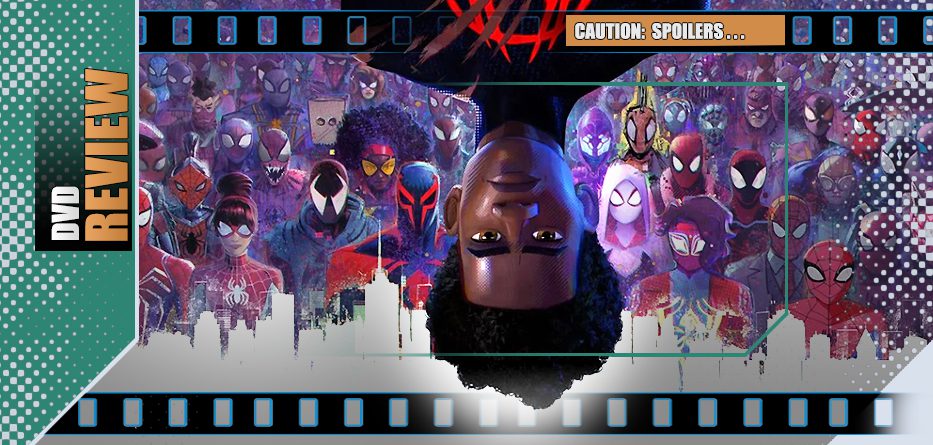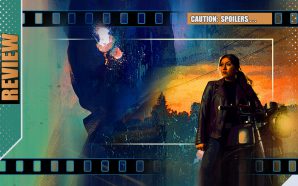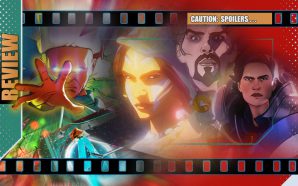With great power comes great responsibility… but does it also come with an inevitable cost? On Earth 1610, Miles Morales swings through the city, taking a welcome break from his school responsibilities as he fights crime and mocks the latest ‘super-villain’ to cross his path – a cheddar-cheesed, physics-defying felon calling himself ‘The Spot’. On Earth-65 Gwen Stacy powers out a drum-solo and quietly mourns the death of her reality’s Peter Parker and tries to deal with the fact that its her own father, Captain George Stacy who is in charge of pursuing the vigilante (and, unknowingly, Gwen’s alter-ego) known as Spider-woman. Dimensions apart and now separated after their previous joint adventure – neither version of the ‘Spider’ feels able to tell those closest to them about their secrets, even as they regularly risk their own lives for them…
Despite their experiences, neither Gwen nor Miles fully appreciates the sheer scale of the multiverse and the ‘Spider’ role within it – but they are about to. As The Spot’s power increases, his ability to affect the multiverse comes into play and Gwen becomes part of a team designated to cross the multiverse to capture him. But when Miles manages to hop along for the ride, chaos ensues and new allies/enemies are introduced. New details about the origin of Miles own powers are about to be revealed, but it’s the future that now matters most and every spider will have to make their choice on where they stand and what they stand for…
*spoilers*
If there was ever a doubt that the multiverse is now the currency of superhero choice, 2023 will likely be the deciding factor. Marvel has already established that its current phase is already about alternatives, what-ifs and sacred timelines and later this month DC catches up as The Flash breaks canon and continuity by colliding with itself. But if there’s one movie that truly exploits the idea, it’s Spider-man: Across the Multiverse, (directed by Joaquim Dos Santos, Kemp Powers and Justin K. Thompson), an unapologetic rollercoaster romp through dimensional disturbances, seeking to power-up the ideas embraced by the 2018 animated film that surprised everyone and took home an Academy Award for its efforts.
Often feeling like an Aha video on Adderall, Across the Spiderverse (the sequel to the Oscar-winning Into the Spiderverse) spins the threads of its story at breakneck speed, encompassing a tale that’s interesting and nuanced at its heart but often feels dominated by the sheer volume of things being thrown at the screen. A maelstrom of imagery and a cacophony of sound combine for something that is immediately, obviously ambitious and beautiful in its own way, but also so overwhelming and messy that you treasure the moments it actually slows down and takes a breath. The problem – simply put – is that there’s too much happening – it’s an eternal avalanche of visual gags, easter-eggs and flourishes so numerous that it would take a multiverse of screenings to capture them all and they all compete for attention so readily that you never really let you get a proper hand-hold as they swing and thwip! by. It’s as if someone was whisking you through a gallery of Vincent Van Gogh, Sydney Pollock, Pierre-Auguste Renoir and Adi Granov without pause for breath – each moment deserving a gilded frame amazing, spectacular and astonishing, but flashing by too quickly to truly appreciate for more than a second.
Often feeling like an Aha video on Adderall, Across the Spiderverse spins the threads of its story at breakneck speed, encompassing a tale that’s interesting and nuanced at its heart but often feels dominated by the sheer volume of things being thrown at the screen… It’s as if someone was whisking you through a gallery of Vincent Van Gogh, Sydney Pollock, Pierre-Auguste Renoir and Adi Granov without pause for breath – each moment deserving a gilded frame amazing, spectacular and astonishing, but flashing by too quickly to truly appreciate for more than a second…
Music and sound-mixing are very important elements in the mix that will likely be more generally overlooked, but credit has to – and will – go to everyone involved with the artistic side of the production, almost guaranteeing that the army of illustrators and renderers will win a slew of further awards simply for the way they present the story. There’s no denying that even with the quantum leaps forward in CGI and performance-capture, the live-action superhero movies often remain at a strategic arms-length from their source-material, but the Spider-verse movies embrace their secret origins with gusto, the animation purposefully echoing the printed pages even as they’re brought to life. Like those self-same comics, some of those styles work better than others, but it’s rarely a boring canvas… with a myriad of styles, combining, clashing and colliding in sometimes complimentary, sometimes crazy and contradictory treatments. One minute we’re sailing through stunningly water-coloured backdrops and subtly-emotive and lovingly-rendered faces and then it’s far more abstract, subversive, punk by way of live-action and Lego (the latter sequence created by a fourteen-year-old auteur who had already recreated the trailer in building blocks). It’s a film that gets and embraces its own joke and runs with it as fast as possible.
The film smartly echoes and continues the key touchstones of the timeless Spider-man mythology, both good and bad: the idea of great responsibility coming from great power; the perils of keeping secrets from those you love the most; the agony and ecstasy of adolescents; the physical freedom of swinging through skyscrapers and the real dangers of mortality when putting yourself in the firing line protected only by your speed and wit. One of the further strands presented here – and the core of the sequel’s dilemma – asks about fate: is every version of the ‘Spider’ across the multiverse defined by a tragic origin, their heroic mission and existence kickstarted by the loss of someone close to them? Miguel O’Hara (the Spider-man of 2099 in the comics) rages against Miles when the latter’s actions alter the canon of a world in which people were destined to die and didn’t because Morales instinctively interfered with events… and causes dimensional disruption. Across the Spiderverse essentially pulls on the strings of that great responsibility and great consequence to equal effect.
The voice-cast/appearances are fun. Shameik Moore and Hawkeye’s Hailee Steinfeld reprise their respective roles as Miles and Gwen with Jake Johnson reprising Peter B. Parker (now with an infant ‘Mayday in tow). Black Panther/ Judas and the Black Messiah‘s Daniel Kaluuya gives cadence to Spider-Punk, and (after Apocalypse in X-Men and the many personas of Moon Knight) Oscar Isaac gives life to yet another Marvel character, this time as the very serious Spider-man of 2099 Miguel O’Hara. Luna Lauren Velez is given more screentime as Miles’ mother as is Jefferson Davis (Miles’ father) played by Brian Tyree Henry. Rio Shea Whigham is George Stacey, Jorma Taccone is the Vulture. There’s other newer characters making immediate impressions such as Karan Soni as Pavitra Prabhakar and Issa Rae as a very pregnant Spider-woman variant. Andy Samberg voices the over-dramatic Ben Reilly / Scarlet Spider, a nod to the ‘Clone saga’, one of the most infamous storylines from the comics. Oliver Muirhead makes The Spot – a villain created in the actions of the first movie – interesting and dynamic and J K Simmons also makes an obligatory vocal cameo as J Jonah Jameson. Elsewhere along the way you’ll also see live-action footage of both Donald Glover as a version of The Prowler and Andrew Garfield as a devastated Peter Parker from the earlier movies and an oblique reference to the Doctor Strange events from No Way Home.
Though mentioned during its creation, what hasn’t been made that clear in recent marketing is that this is not a complete story… if you aren’t watching the clock, you’re likely to be surprised and a mite frustrated when the climactic ‘How are they going to get out of that?‘ situation ends the movie after nearly two -hours with a ‘To Be Continued…‘ box that won’t be open and fulfilled until the Spring of next year (or longer, depending on the current strike-issues) and the last part of the trilogy: Beyond the Spider-verse. Also of note, there’s no additional secret scene to spin through, though the credits themselves look lovely.
But for the moment, Across the Spider-verse proves a dynamic if manic sequel and one that was worth the four-year wait…

- Story9
- Animation10
- Voice-acting9
- Art-Direction10











